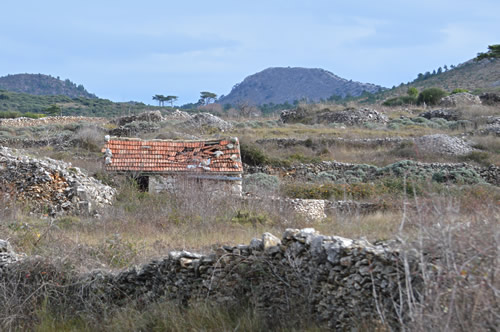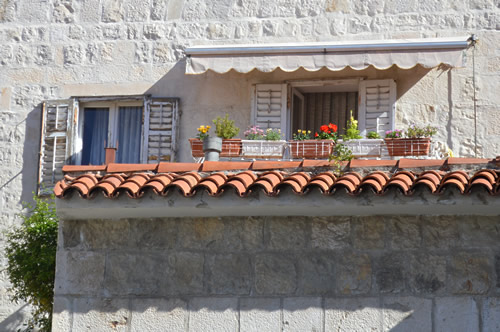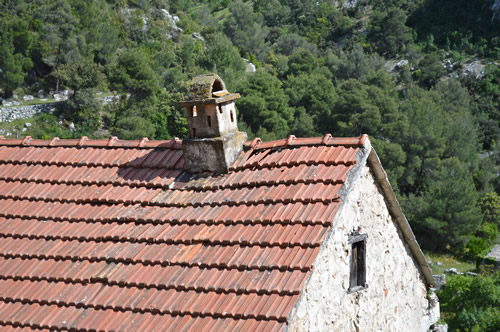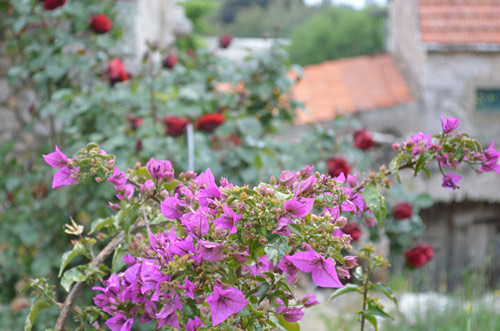I love the look of the traditional Dalmatian houses – they fit so perfectly into their environment. Which, when you think about it, makes a lot of sense, as the building materials are also likely to have come from the very same landscape!
The stone and red clay would at one time have been locally sourced, though nowadays your choice may include Italian, Spanish or French products. All across the northern shores of the Mediterranean – in Spain, France, Italy, Croatia and Greece – our idea of a picturesque building in that setting comes with a red roof.
The red of those roofs looks so natural against the green of the trees and the blue of the sky and sea. And the fields – just look at the colour of the local soil on the Stari Grad plain, the same intense red as you see on the roofs!
It’s amazing how even a single red roof can enhance any landscape. Here we have lavender fields in winter, with a single building making the picture perfect. Blue and orange is a winning combination!
And even if the building may be old and the roof far from perfect, the scene is still much enlivened by that flash of orange!
Red clay roof tiles have been around since the days of the ancient Greeks and Romans. In Latin, the material was known as terra cotta (baked earth), and the tiles could be made glazed or unglazed. The classic half-pipe shape of a Roman roof tile was said to have been produced by bending the flat tile over the maker’s thigh. After shaping, the tiles were fired in a kiln, at around 1,000 °C (1,830 °F).
The colour of the resulting terracotta varies with the source of the clay, from a pale buff-yellow, through pink and orange to fairly deep reds and chocolate brown. It all depends on the percentage of iron oxide content, and how far from the heat the tile was during firing.
The temperature within the old wood-fired kiln was pretty uneven – tiles closest to the fire cooked better turning a darker red, while tiles farther from the flames ended up lighter orange in colour. Look at the differences in the tiles here!
These days, more modern mass-produced roof tiles can stand out as a rather uniform bright orange amongst the more subtle variations on the older roofs. The effect is most striking in Dubrovnik, where the new tiles mark out the roofs that were damaged by shell-fire in the 1991 war for independence.
Fired terracotta is not watertight, in fact it’s porous, which does make you wonder why they thought of using this material to keep out the rain! However, there are ways to improve its performance by surface-burnishing before firing and/or adding a layer of glaze. The big advantage of terracotta for covering a roof is that it’s light, and can be cheaply made. Some older buildings in Dalmatia, especially in rural areas, have a stone roof, built with flat pavers. Many of these old roofs are not in a good state of repair.
Sometimes a stone roof may be topped with a line of clay ridge tiles, but not always. Stone roofs are nearly always very old, although for an important historical building, such as a church or small chapel, the stone is maintained to keep the original appearance. Of course, a stone roof is considerably heavier than an equivalent tile roof.
Naturally, both stone and terracotta tiles are both an improvement on any kind of thatched roof in terms of fire. But you do need a relatively strong stone building to support them, not a simple wooden or mud-brick structure.
I think of the traditional Dalmatian roof tile as the rounded barrel shape. You see them a lot here, and it’s also very common across Italy and Spain. However, when we were renovating our house, we were recommended to use what was called “Francuske pločice” or French tiles. Those have a flatter profile, and interlock for a better resistance to wind and water penetration. Not a bad recommendation for an area so prone to strong winds in the winter!
As you look around, you see several variations on the tile shapes. Each contributing something different to the townscape. Imbrex and tegula was the ancient Roman pattern of curved and flat tiles that created rain channels between the curved sections.
Barrel tiles are laid in alternating columns of convex and concave tiles – also known as cap and pan construction.
Interlocking roof tiles – known in our part of the country as French tiles – flatter tiles with side and top locking to keep out wind and wet.
One disadvantage of the higher profile of the barrel type tiles is their tendency to collect debris, and then you get seeds sprouting up there. On the whole, I’m really glad that I don’t have to get out there and weed my roof!
And lastly, I wanted to share with you an appropriate quote on the subject from the wonderful Les Dawson…
In awe, I watched the waxing moon ride across the zenith of the heavens like an ambered chariot towards the ebony void of infinite space wherein the tethered belts of Jupiter and Mars hang, forever festooned in their orbital majesty.
And as I looked at all this I thought… I must put a roof on this toilet!





















I love the red roofs — and your painting from the photos.– Nancy
Thanks, Nancy! I may post the painting here when it’s finished – still working on that dark foreground!